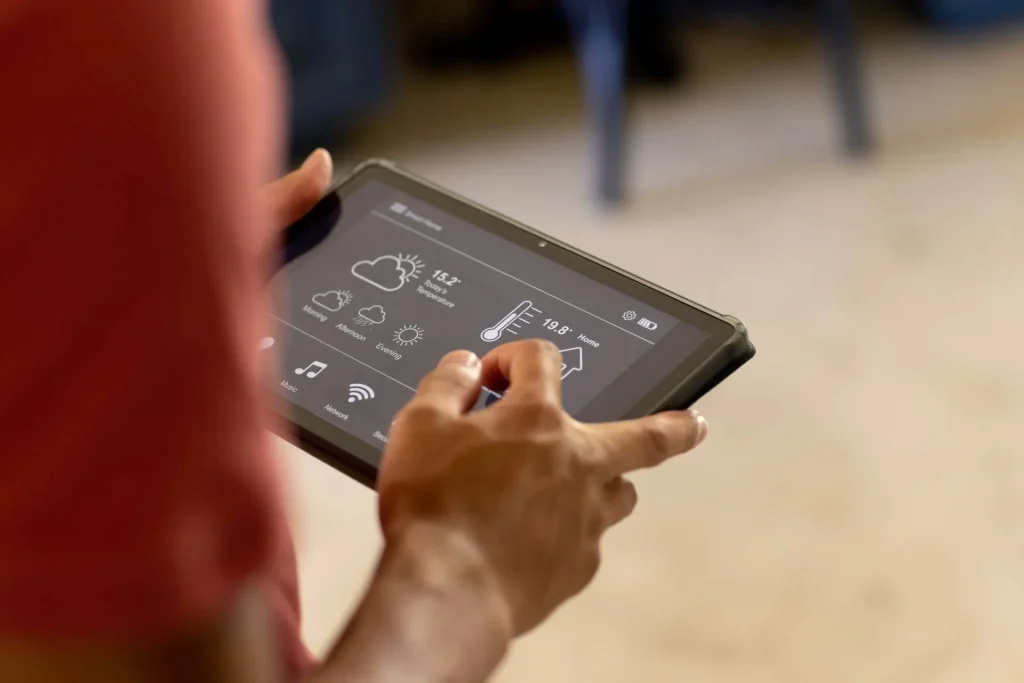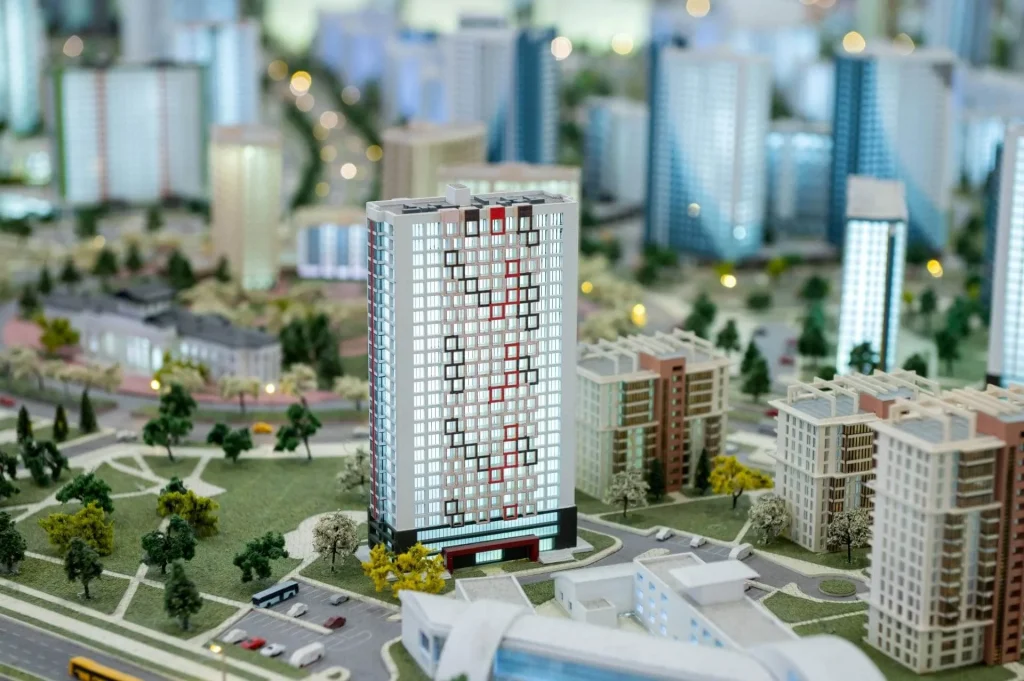The Philippines’ urban population is evolving rapidly, and condos in Tagaytay are completely upending the real estate industry. As the country becomes more urbanized and the demand for modern living spaces rises, smart condos in this charming city which blend cutting-edge technology with contemporary architecture and sustainable living practices are redefining urban life.
Revolutionizing Smart Condos in the Real Estate
Through the use of a user-friendly touchscreen panel or their smartphones, occupants of smart homes can effortlessly manage and access their living areas, thereby revolutionizing urban high-rise living. It uses personalization and home automation concepts to enable the programming of unit devices, such as light switches.
A novel type of condominium, smart condos are made to cater to the demands of contemporary city dwellers. They go above and beyond conventional housing by incorporating convenience, sustainability, and technology into daily life. Automated systems, energy-efficient designs, and a variety of amenities that meet the needs of a population that is becoming more environmentally conscious and tech-savvy are just a few of the inventive aspects that define these developments.
What Is a Smart Condo?
A smart condo or a smart home sometimes referred to as a smart apartment or smart house, is a type of residential space where a variety of smart home technology and gadgets are integrated to improve the ease, security, energy efficiency, and general standard of living for the occupants. Smartphones, tablets, and other devices can be used to remotely control and monitor these technologies, which are usually networked.

Important Smart Condo Features
- Automation systems are used in smart condos to regulate the lighting, HVAC (heating, ventilation, and air conditioning) system, as well as other appliances. For comfort and energy savings, residents can remotely control, modify, or schedule these systems.
- Security: Motion sensors, security cameras, video doorbells, and smart locks are common components of smart security systems in condominiums. With the help of these devices, homeowners can remotely monitor and secure their properties in real-time through alerts and surveillance.
- Voice assistants: You can control a number of things in the condo with voice-activated devices like Google Assistant or Amazon Alexa, including playing music, adjusting the thermostat, and delivering information.
- Energy management: In addition to having energy-efficient appliances, smart condos frequently make use of smart lighting and thermostats to maximize energy savings. A lower carbon footprint and lower energy costs may result from this.
- Appliances that can be remotely controlled and monitored include washing machines, refrigerators, ovens, and other types of “smart” appliances.
How Do Smart Condos Operate in the Philippines?
In the Philippines, people can live in very comfortable, secure, and energy-efficient smart condos. The developer and the condominium project’s budget will determine how integrated and feature-rich the design is.
Three things are needed for smart homes to work: actuators, controllers, and sensors. Sensors such as temperature and motion detectors gather information about the surroundings inside and outside the house. After analyzing the data, controllers determine what should happen next (typically through an app on your smartphone or tablet). Actuators then carry out the controller’s directives, which include dimming the lights when a person exits a room.
The Growth of Eco-Friendly Housing in Real Estate
Growing awareness of environmental issues, a desire for energy efficiency, and a dedication to lowering the carbon footprint of residential and commercial properties are the main drivers behind the significant trend of sustainable living in real estate. In real estate, sustainable living refers to a range of behaviors and attributes that support socially and environmentally conscious living.
Energy efficiency is a key component of sustainable living in real estate because it decreases the environmental impact of both residential and commercial properties while also cutting operational costs. A common focus of sustainable real estate is utilizing solar energy, LED lighting, energy-efficient HVAC systems, and well-insulated buildings. Long-term sustainability and durability are greater for properties that use less energy. They require less frequent upkeep and renovations because they are less likely to experience wear and tear. This helps to ensure the property’s long-term viability.
In an effort to show their dedication to sustainability and draw in eco-aware tenants or buyers, many properties are pursuing green certifications such as Energy Star or LEED (Leadership in Energy and Environmental Design). The certificate greatly impacts Real estate sustainability, which offers third-party confirmation of a property’s environmental performance and dedication to eco-friendly standards.
An important contributing factor to the rise of eco-friendly housing is the emphasis on healthy indoor environments. Developing living environments that put residents’ health and well-being first is not only a morally right decision, but it can also serve as a significant impetus for the uptake and spread of environmentally friendly housing. Not only can healthy indoor environments coexist with eco-friendly housing, but they are also essential to its expansion and prosperity. The core values of sustainability and environmental responsibility are aligned with the prioritization of resident health and well-being, which makes eco-friendly housing an appealing option for an increasing number of environmentally conscious individuals and families. It represents an all-encompassing strategy for sustainable living that takes into account not only the environment but also the lives of the people who live in these environmentally friendly homes.
Waste reduction tackles one of the biggest issues in building construction and operation: the creation of waste during construction and continuous waste during occupancy. This is why waste reduction is essential to the expansion of environmentally friendly housing. The environmental impact of extracting, manufacturing, and transporting building materials is reduced when construction waste is reduced. It reduces energy use, greenhouse gas emissions, and the need for natural resource conservation. By lowering disposal costs and the need to buy and transport extra materials, cutting waste in construction can result in significant cost savings. The ability to pass these savings on to investors or homeowners increases the financial appeal of eco-friendly housing.

Amenities and Community Living in a Smart Home
A smart home’s amenities and community life can improve its inhabitants’ quality of life by incorporating cutting-edge technology into their everyday routines and encouraging a feeling of community.
The Benefits of living in a smart home
Automated smart homes
Smart houses are outfitted with gadgets that may be operated from a distance using voice commands or smartphones. From the comfort of their iPhones or other devices, residents may manage the lighting, heating, cooling, security, and entertainment systems. The process of combining several systems and gadgets in a house to facilitate management, control, and monitoring via a centralized network is known as a smart home system. Typically, this system makes use of Internet of Things (IoT) technology, which enables gadgets to interact with one another, be operated from a distance, and frequently pick up on and adjust to the preferences of the occupants.
Certain wearable technologies and smart homes can be connected, enabling data sharing and health monitoring with medical professionals and emergency services. This technology defines geographic boundaries using RFID or GPS. Your smartphone can control certain functions, like turning on or off lights, adjusting the thermostat, or locking doors, when it enters or exits the designated area.
Energy efficient
Based on schedules and real-time usage patterns, these devices learn the habits of the residents and modify the heating and cooling. When no one is home, they can optimize the temperature settings, which can result in significant energy savings. Energy-saving devices like LED lights, energy-efficient appliances, and smart thermostats are common in smart homes. This lowers utility costs while simultaneously promoting environmental sustainability.
Traditional incandescent bulbs are less energy-efficient and have a shorter lifespan than LED bulbs. By pairing them with smart controls, you can reduce unnecessary energy consumption with features like motion-sensing, scheduling, and dimming. Washing machines, dryers, refrigerators, and dishwashers are examples of smart appliances that can be remotely controlled to maximize energy efficiency during off-peak hours. These appliances also frequently have energy-saving modes.
To lessen reliance on the grid, smart homes can incorporate solar panels or other renewable energy sources. Systems for storing batteries make it possible to store extra energy for later use. Energy-efficient materials like improved insulation, double-glazed windows, and reflective roofing materials are frequently used in the construction or renovation of smart homes, all of which naturally reduce energy consumption.
Certain intelligent systems utilize artificial intelligence algorithms to examine usage trends and enhance energy efficiency. With time, these systems pick up on the routines of the residents, maximizing their efficiency.
Environmental Initiatives
Eco-friendly initiatives like recycling programs, effective waste management, and the use of renewable energy sources like wind turbines or solar panels can be implemented in smart communities. Renewable energy sources like solar panels, wind turbines, and geothermal systems are frequently used in smart homes. By producing clean energy, these sources lessen the household’s carbon footprint and dependency on conventional power grids.
Certain smart homes have agricultural and gardening technologies that are sustainable. Water-efficient gardening techniques are enhanced by the use of soil moisture sensors, automated irrigation systems, and plant health monitoring systems. Real-time data and analytics on the use of energy, water, and resources are provided by smart systems. With this knowledge, locals can optimize their consumption for sustainability, modify their behavior, and make well-informed decisions.
In order to improve sustainability, smart homes are always incorporating new upgrades and technology. To further enhance the environmental impact, innovations in automation, connectivity, and energy-efficient devices are combined.
Well-being and Health
Health and wellness programs in smart homes include a range of devices and setups intended to improve occupants’ quality of life. These programs are designed to address particular health needs, enhance comfort, and encourage healthier lifestyles.
Blood pressure monitors, scales, and wearable fitness trackers are just a few examples of the many health monitoring gadgets that can be included in smart homes. For improved health management, data from these devices can be shared with healthcare providers or integrated with health apps. With sensors that identify allergens, humidity, and pollutants, smart homes can control and monitor the quality of the air indoors. When the air quality decreases, this data can be used to turn on air purification systems, change ventilation, or notify residents.
Smart homes can be outfitted with emergency alert systems that will instantly contact emergency services or caregivers in the event of an emergency. This is especially beneficial for the elderly or people with certain medical issues. Smart homes can be outfitted with assistive technology such as fall detection systems, voice-activated controls, and smart walkers to facilitate independent living for senior citizens or people with mobility issues.
Obstacles and Factors to Consider in Implementing a Smart Home System
Despite having many high-tech features, smart condos may not be accessible to a wider range of people due to their high entry costs. The initial cost of purchase and possibly increased maintenance costs may prevent people in the middle class or lower from taking advantage of these developments in urban living. For developers, striking a balance between affordability and technological integration is still a major challenge.
One issue with smart condos is the speed at which technology is developing. In a few years, the devices and systems integrated during construction might become antiquated. As a result, maintaining current technology may necessitate further expenditure or improvements, which could result in differences between older and newer apartments in the same building.
Although technology is convenient, residents may have a steep learning curve due to the complexity of integrated systems. It is crucial to make sure that residents can comprehend and adjust to these systems with ease, and that user interfaces are user-friendly. Taking into account the residents’ varying degrees of technological literacy also becomes important. Integration of different systems is critical to smart condos. It is essential to guarantee compatibility and a strong infrastructure in order to support these systems. Any flaws or malfunctions can interfere with day-to-day operations, impacting not only residents’ convenience but also their safety and security.
A multitude of networked devices raises the possibility of privacy violations and cyberattacks. It becomes crucial to protect private information and make sure integrated systems are secure from potential hackers and cyberattacks. To fix any vulnerabilities, developers must put strong cybersecurity safeguards in place and update their systems frequently.
It can be difficult to foster a sense of community in smart condominiums. Residents’ inadvertent face-to-face interactions may be hampered by the reliance on technology. A building’s intentional planning and design, such as the inclusion of socially interactive common areas, are essential to fostering a sense of community and social engagement.
In the Philippines, the smart home is transforming city living. They are a desirable option for city people since they provide the ideal balance of modernity, sustainability, and ease. Developers, tenants, and local government must work together to create tech-savvy, sustainable, and dynamic urban communities that meet the changing needs of the Filipino people as the demand for smart condos rises. The emergence of smart condos is a sign of good things to come for urban living in the Philippines in the form of more advanced, connected, and environmentally conscious cities.
Read more: Why Living in a Smart Condo Will Be Your Best Move


